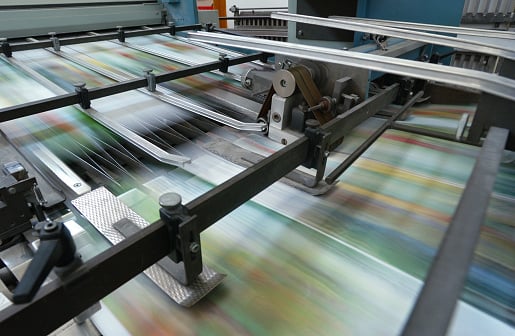Offset Printing
The inked image is transferred (or "offset") from a plate to a rubber blanket, then to the printing surface, in the widely used printing technique known as offset printing. When combined with the lithographic method, which relies on the attraction of water and oil, the offset technique uses a flat (planographic) image carrier on which the image to be printed receives ink from ink rollers while the non-printing area attracts a water-based film (referred to as "fountain solution"), keeping the non-printing areas ink-free.
Offset Printing in the Present
One of the most used techniques for producing printed material is offset lithography. Newspaper periodicals, brochures, stationery, and books are just a handful of the frequent items it is used for. In comparison to other printing techniques, offset printing is best suited for creating huge quantities of high-quality prints affordably in a way that requires little upkeep. The quality of contemporary offset presses is further improved by the usage of computer-to-plate systems rather than the more traditional computer-to-film workflows.
When compared to other printing techniques, offset printing has the following advantages:
- Constantly Excellent Visual Quality - Compared to, say, letterpress printing, offset printing more easily generates precise, clear images and types because the rubber blanket adapts to the structure of the printing surface.
-
Printing Plates May Be Produced Quickly and Easily
-
More Enduring - Because there is no direct contact between the printing surface and the plate, there is a longer printing plate life than on direct litho presses. With the use of properly designed plates, appropriate inks, and fountain solutions, run times of over a million impressions may be possible.
- Favorable to Budget - The least expensive way to create prints with good quality and large print quantities is offset printing.
Offset printing also has the benefit of allowing you to use screw keys to modify the amount of ink on the fountain roller. The amount of ink that is transported from the ink trough to the fountain roller is often controlled by a metal blade. The amount of ink applied to the roller can be raised or decreased in specific regions by changing the screws that control the space between the blade and the fountain roller. As a result, the color density in the corresponding area of the image is changed. Older machines require manual adjustment of the screws, while current machines use electronic screw keys that are controlled by the printer that runs the machine, giving a far more accurate outcome.
Offset's Benefits
- High-quality images.
- Works on a variety of printing media, including rough paper, plastic, wood, metal, fabric, and paper.
- As the quantity increases, the unit cost decreases.
- Quality and economical efficiency in high-volume jobs. While modern digital presses can create high-quality work at a cost/benefit ratio that is comparable to offset, they are not yet able to match the volume that an offset press can generate.
- Further improving quality, a lot of contemporary offset presses use computer-to-plate systems rather than the more traditional computer-to-film workflows.
Offset Printing Explained Visually
Since its founding in 2003, Henan Huida Print-All Technology Co., Ltd, the company produces 40 million square meters on 4 high-speed production lines each year. Numerous nations in Europe, the ASEAN, South Asia, America, and Africa are among the destinations for exports. Contact us at any time if you have any order requests!

